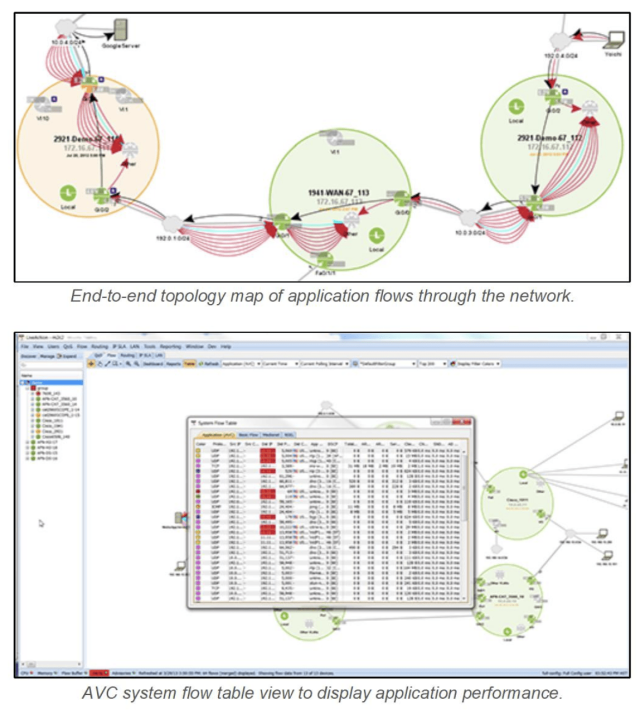
How Can Cisco Application Visibility and Control be Used to Monitor Application Performance?
The Cisco Application Visibility and Control (AVC) solution deploys a holistic approach for managing quality of service (QoS) technologies. It intelligently prioritizes traffic for critical applications while reducing or preventing traffic from noncritical or unwanted applications in an attempt to improve network and application performance over a wide area network (WAN).
Application Performance and Cisco Application Visibility and Control When network traffic becomes overloaded, network latency begins to suffer. Application performance that relies on this congested network in turn begins to suffer. Because of this, overall user experience, customer experience, and enterprise productivity suffers. Cisco AVC aims to manage the ever-increasing demands on enterprise networks and prevent this type of scenario.
Networks carry the traffic of all applications either critical or non-critical, and since the explosion of cloud computing, there is now a plethora of vendor cloud services competing for bandwidth on many enterprise networks—it is within this environment that Cisco AVC is designed to:
- Make visible network traffic — The modern cloud app is generally accessible anywhere; it can evade network security standards by switching ports and protocols and may even avoid them by tunneling within other services. Cisco AVC uses deep packet inspection, statistical classification, socket caching, service discovery, auto learning, and DNS as an Authoritative Source (DNS-AS) to identify and classify all application traffic.
- Make application-level classifications — Rather than classifying network traffic via ports and protocols, which no longer is as useful as it once was for filtering network traffic, Cisco AVC creates an application-aware network that identifies applications to a deep granularity. This allows for precision awareness, control of business-critical applications, and real-time performance optimization. Cisco AVC uses industry leading QoS capabilities across routers, campus switches, access points, and wireless controllers to coordinate and re-prioritize traffic.
- Make insights visible through data — Application and network analytics are key to understanding how best to enhance network performance and ward off network intrusions. Cisco AVC offers advanced analytics and reporting through the use of NetFlow. Reporting platforms like Cisco Prime Infrastructure and Cisco Stealth watch, using NetFlow data exports, are capable of identifying users across devices or IP addresses, using granular precision controls that can track user, groups of users, and specific machines, and allows for the control of what traffic flows are allowed to enter or exit the network.
How does Cisco Application Visibility and Control Improve Application Performance?
Cisco AVC performs deep packet inspection (DPI) on network traffic in order to reconstruct network flows instead of processing packets as individual events, in effect, following all the data clues to construct a real-time representation of network traffic fully visible. This ability to recognize flows allows admins to track traffic with precision at application-level and even session-level granularity.
Cisco AVC can combine with performance visualization software providing admins with innovative visual displays, real-time big data analytics, and deep control of quality of service (QoS) devices like routers and switches.
For example, the LiveAction solution is an application-aware network management software with quality of service (QoS) controls. Based on a See-Point-Click-Fix process model, LiveAction features include:
- See: Visualization
○ Visualize real-time end-to-end network traffic
○ Examine historical QoS, flow, routing, and IP service-level agreement (IP SLA) data - Point: Decision making:
○ Analyze hop-by-hop path, devices, interfaces, and queues
○ Locate and troubleshoot problems - Click: Control
○ Enable and deploy QoS, Network-Based Application Recognition (NBAR), Flexible NetFlow (FNF), Cisco Application Visibility (AVC), and Cisco Medianet
○ Create IP SLA probes and Media Services Interface (MSI) endpoints - Fix: Improve
○ Edit QoS policies, access control list (ACL), Policy Based Routing (PBR), and IP SLA
Cisco AVC makes it possible to actively manage networks with full control over visibility, and decision making.

Related Terms
PerfMon
Short for Performance Monitor, the Cisco PerfMon API gives clients access to platform, service, and application performance counters allowing them to monitor in real-time the Cisco Unified Communications Manager (Cisco Unified CM) software and hardware.
What this means is that by monitoring packet flows in the network an admin can anticipate network issues before they begin, detect bottlenecks, and actively improve performance. Performance monitoring is highly significant for real-time applications such as streaming video traffic or VoIP which carries data that expires quickly and is especially sensitive to packet loss.
MOS Score
The mean opinion score (MOS) measures the quality of experience of real-time telecommunications such as video, audio, and audiovisual applications.
Quality of Service (QoS) Quality of service (QoS) is a qualitative measurement of the overall performance of services like telephony, computer networks, and cloud computing. QoS may also refer to the set of technologies and strategies that organizations deploy, aimed at optimizing network traffic in order to improve the user experience of their apps. QoS approaches are commonly applied to real-time applications, such as VoIP, video-on-demand, streaming video or online gaming where transmission quality is at a premium.



